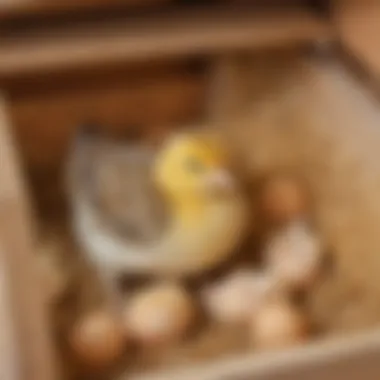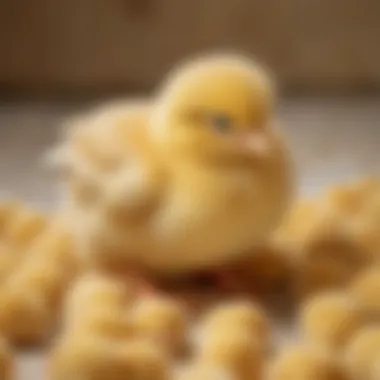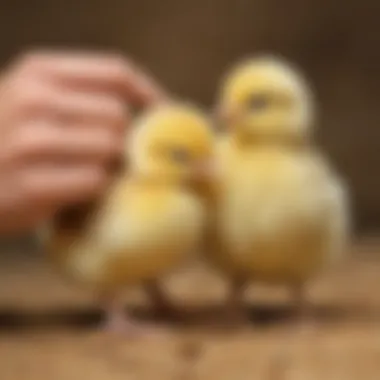Mastering the Art of Caring for Newly Hatched Chicks: A Comprehensive Guide


Science Fun Facts
Did you know that newly hatched chicks are capable of seeing more colors than adult chickens? This heightened color vision helps chicks better locate food and stay safe from predators in their first days of life. Additionally, chicks have an innate ability to recognize their mother hen's distinct clucks from other sounds, allowing them to seek comfort and security.
Discover the Wonders of Science
In exploring various scientific concepts related to newly hatched chicks, we encounter the remarkable phenomenon of imprinting. Imprinting is a crucial process wherein chicks form strong attachments to the first moving object they see after hatching, typically their mother. This behavior helps chicks identify their caregiver and enables smooth social integration within the flock.
Science Quiz Time
Test your knowledge on the fascinating world of newly hatched chicks with these multiple-choice questions:
- What is the purpose of a brooder in chick rearing? a) To provide warmth and a secure environment b) To teach chicks how to fly c) To encourage chick independence at an early age d) To regulate the chick's sleeping patterns
- Why is proper handling essential for newly hatched chicks? a) To develop a bond of trust between chick and caregiver b) To discourage chicks from imprinting on humans c) To increase the chicks' fear of handling d) To promote aggression in chicks
Science Experiment Showcase
Engage in a fun and educational experiment focusing on chick behavior. Experiment Name: Exploring Chick Imprinting Materials Needed:
- Newly hatched chicks
- Various objects (e.g., stuffed animals, rubber balls)
- Stopwatch
- Observation journal Safety Tips and Precautions: Ensure adult supervision at all times during the experiment. Handle chicks gently and avoid sudden movements to prevent stress. Happy experimenting!
Preparing the Brooder
In this comprehensive guide on how to care for newly hatched chicks, the section on preparing the brooder is of utmost importance. Setting up the brooder correctly is crucial for the health and well-being of young chicks. It provides them with a safe and warm environment that mimics the conditions they would experience with their mother. Properly preparing the brooder sets the foundation for successful chick rearing, ensuring they have the ideal space to grow and develop.
Choosing the Right Brooder
Selecting an Appropriate Size
When it comes to choosing the right brooder, one of the key aspects to consider is selecting an appropriate size. The size of the brooder plays a crucial role in providing sufficient space for the chicks to move around comfortably. It needs to accommodate the number of chicks you have adequately. An appropriately sized brooder prevents overcrowding, which can lead to stress and aggression among the chicks. Ensuring that each chick has enough space to move freely promotes their health and growth. Though often underestimated, the size of the brooder is a critical factor that contributes significantly to the well-being of the chicks in this pivotal stage.


Ensuring Proper Ventilation
Another essential aspect of the brooder is proper ventilation. Adequate ventilation is vital for maintaining good air quality inside the brooder. It helps regulate temperature, reduce humidity levels, and prevent the buildup of harmful gases. Proper ventilation ensures that the chicks have access to fresh air, promoting respiratory health and overall well-being. While this may seem like a minor detail, ensuring proper ventilation in the brooder is crucial for creating a healthy environment that supports the chicks' growth and development.
Setting Up the Brooder
Providing Bedding Material
Choosing the right bedding material is crucial for creating a comfortable and hygienic environment for the chicks. The bedding material should be soft, absorbent, and easy to clean. It helps cushion the chicks, absorbs moisture, and provides them with a warm and cozy space to rest. Good bedding material also helps prevent the chicks from slipping and getting injured. Selecting the right bedding material is a thoughtful decision that greatly contributes to the overall well-being and comfort of the chicks in the brooder.
Adjusting Temperature Settings
Maintaining the correct temperature in the brooder is essential for the chicks' survival and growth. Adjusting the temperature settings accordingly ensures that the chicks are kept warm and comfortable. Too cold or too hot temperatures can be detrimental to the chicks' health. A stable and controlled temperature is crucial for their well-being, helping them regulate their body temperature and conserve energy for growth. Paying attention to temperature settings and making necessary adjustments is a critical aspect of setting up the brooder correctly, laying the foundation for healthy chick development.
Feeding and Watering
Feeding and watering play a crucial role in the care of newly hatched chicks. It is essential to provide the right nutrition and hydration to support their growth and development. Proper feeding ensures that the chicks receive the necessary nutrients to thrive, while adequate watering helps in maintaining their overall health and vitality.
Choosing the Right Feed
Selecting the appropriate feed for your chicks is vital for their well-being. The type of feed you choose can impact their growth, immunity, and overall health. Starter feed is a popular choice for newly hatched chicks due to its balanced nutritional content and ease of digestibility. It contains essential vitamins, minerals, and proteins needed for the chicks' early development. One key advantage of starter feed is its formulation specifically for young chicks, ensuring that they receive the required nutrients for a healthy start.
Supplementing with Grit
Supplementing the chicks' diet with grit is another important aspect of their nutrition. Grit aids in digestion by helping the chicks grind down their food in the gizzard. It is particularly beneficial for chicks that do not have access to outdoor foraging opportunities. Including grit in their diet ensures efficient food breakdown and nutrient absorption. While grit supplementation offers digestive benefits, it is essential to monitor the chicks' intake and provide the right type and size of grit suitable for their age and size.
Watering Requirements
Providing clean water is fundamental for the chicks' hydration and well-being. Clean water prevents dehydration and supports proper bodily functions. It is essential to offer fresh water daily, ensuring that it is free from contaminants and debris. Accessible water sources help keep the chicks healthy and hydrated throughout the day.
Avoiding Spills


Avoiding spills during watering is crucial to maintain cleanliness in the brooder area. Spills not only lead to wastage of water but can also create damp conditions that are unfavorable for the chicks' health. Implementing spill-resistant water containers and placing them on stable surfaces can help prevent spills. Regularly checking and refilling the water containers minimize the risk of spills and ensures that the chicks have continuous access to clean water.
Handling and Health
In this exhaustive manual on the care of neewly hatched chicks, the section on emerges as a pivotal aspect safeguarding the well-being and development of our fragile companions. Understanding the nuanced interaction between and establishes a foundational element in poultry care.
Proper Handling Techniques
Within the broader scope of the subsection provides vital guidance on executing precise care for newly hatched chicks.
Gentle Approach
Delving into the is tantamount to cultivating a relationship built on trust and respect with your avian counterparts. The hallmark of the lies in its ability to mitigate stress and foster a sense of security among the chicks, ultimately contributing to their overall well-being and development. Employing a soft touch and soothing voice forms the essence of the rendering it a preferred methodology in this narrative due to its profound efficacy and gentle impact. Embracing the subtleties of the ensures a harmonious interaction with chicks while acknowledging its slight limitation in challenging situations, thereby solidifying its position as a cornerstone in this lexicon of chick care.
Avoiding Stress
The concept of intertwines deeply with the welfare of newly hatched chicks, underscoring the significance of maintaining a tranquil environment for their flourishing. By steering clear of loud noises, sudden movements, and overcrowding, practitioners can provide a serene sanctuary for chicks to thrive. The principle characteristic of lies in its ability to preserve the psychological and physical health of chicks, positioning it as a favorable methodology in this conversational exchange. Its primordial feechre of streamlining the chick's environment underscores its pivotal role in nurturing a peaceful and conducive atmosphere, albeit with occasional challenges in implementation, solidifying its merit within this overarching discourse.
Monitoring Chick Health
As custodians of the burgeoning chick population, the subsection adopts a vigilant stance aimed at early detection and mitigation of potential health anomalies in our feathered charges.
Checking for Signs of Illness
Scrutinizing for stands as a prerogative in nurturing an environment conducive to optimal chick well-being. The primary essence of lies in its preemptive nature, enabling caretakers to intervene promptly at the onset of any deviation from the normal health trajectory of chicks. Its unique trait of promoting proactive health management dubs it a beneficial stratagem for this narrative, despite the occasional challenges like false alarms, attesting to its pertinence in fostering a health-conscious setting.
Consulting a Veterinarian
The denouement of culminates in the directive to an endeavor vital in securing the utmost welfare of our avian charges. Advocating for professional guidance in case of intricate health queries serves as the cornerstone of preventative healthcare for chicks, urging caretakers to proactively address any health concerns beyond their purview. The salient feature of is its capacity to proffer specialized insights and tailored interventions, positioning it as an indispensable recourse in this narrative despite the occasional logistical hurdles, reinstating its indispensable role in nurturing a thriving chick cohort.
Socialization and Environmental Enrichment


Socialization and environmental enrichment play a crucial role in ensuring the well-being and development of newly hatched chicks. By promoting social interactions and creating a stimulating environment, you can help chicks grow into healthy and well-adjusted poultry. Socialization introduces chicks to different scenarios, helping them adapt to various situations as they mature. Environmental enrichment, on the other hand, ensures that the surroundings of the chicks are conducive to their physical and mental growth. This is vital for their overall health and happiness.
Promoting Social Interactions
Introducing Perches and Toys: Introducing perches and toys is essential for promoting physical activity and mental stimulation among chicks. Perches allow chicks to exercise their muscles and provide them with a sense of security by mimicking their natural roosting environment. Toys, on the other hand, help prevent boredom and encourage play, which is crucial for the chicks' social and cognitive development.
Group Dynamics: Understanding group dynamics among chicks helps create a harmonious environment within the flock. By observing how chicks interact with each other, you can identify potential issues like aggression or stress and take appropriate measures to address them. Healthy group dynamics contribute to the overall well-being of the chicks, fostering social bonds and reducing instances of conflict.
Creating a Stimulating Environment
Natural Lighting Exposure: Providing natural lighting exposure helps regulate the chicks' circadian rhythms, promoting healthy sleep patterns and growth. Natural light also supports vitamin D synthesis, essential for calcium absorption and bone development. Ensuring adequate exposure to natural light mimics the chicks' natural habitat, contributing to their physiological well-being.
Exploration Opportunities: Offering exploration opportunities, such as varied terrain and hidden treats, encourages chicks to exhibit natural behaviors like foraging and curiosity. This type of environmental enrichment stimulates the chicks' cognitive abilities and promotes physical activity. Providing opportunities for exploration enhances the chicks' spatial awareness and problem-solving skills, making their environment engaging and enriching.
Transitioning to the Coop
Transitioning the newly hatched chicks to the coop is a critical phase in their development. This process ensures that the chicks adapt well to their new environment, promoting their growth and integration with the existing flock. Gradual introduction plays a key role in reducing stress and allowing the chicks to acclimate gradually to the coop's temperature and dynamics. It is essential to monitor their behavior and health during this transition period to ensure a smooth adjustment.
Gradual Introduction
Adapting to External Temperatures
Adapting to external temperatures is a crucial aspect of transitioning the chicks to the coop. As these young birds move from the controlled environment of the brooder to the outdoor conditions, they need to gradually adjust to varying temperatures. Providing proper insulation and drafts protection in the coop is essential to help the chicks regulate their body heat efficiently. Monitoring their response to temperature changes and making necessary adjustments will aid in their overall well-being and development.
Integrating with Older Chickens
Integrating newly hatched chicks with older chickens is a strategic process that requires careful consideration. Establishing a pecking order within the flock is natural but can cause stress to the younger members. Providing adequate space, multiple feeding stations, and supervision during interactions are vital for a harmonious integration. Older chickens can teach the newcomers social behaviors and help them integrate into the existing flock dynamics. Observing their interactions and intervening if necessary can ensure a successful integration process.
Establishing Routines
Feeding Schedule
Creating a consistent feeding schedule is fundamental in maintaining the health and growth of the newly hatched chicks. A balanced diet with the right nutrients is essential for their development. Regular feeding times help establish a routine that the chicks will become accustomed to, promoting healthy eating habits. Monitoring their feeding behaviors and adjusting portion sizes accordingly will ensure that each chick receives adequate nutrition for optimal growth and vitality.
Checking Roosting Behavior
Observing the roosting behavior of the chicks is integral to their well-being in the coop. Roosting is a natural instinct for chickens, and providing proper roosting spaces encourages this behavior. Monitoring how the chicks perch at night, ensuring they are safe from predators, and comfortable during rest are key aspects of observing their roosting behavior. Any signs of discomfort or unease should be addressed promptly to maintain their health and ensure a good night's sleep for the chicks.







